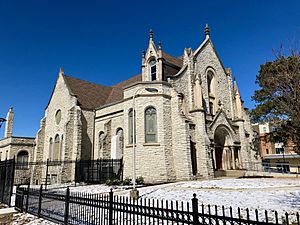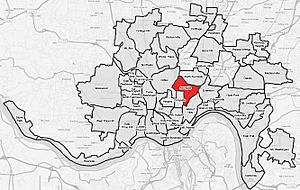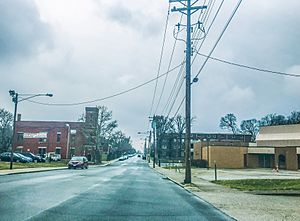Avondale, Cincinnati facts for kids
Quick facts for kids
Avondale
|
|
|---|---|
|
Neighborhood of Cincinnati
|
|

Carmel Presbyterian Church, Avondale
|
|

Avondale (red) within Cincinnati, Ohio
|
|
| Country | United States |
| State | Ohio |
| County | Hamilton |
| City | Cincinnati |
| Population
(2020)
|
|
| • Total | 11,345 |
| ZIP code |
45229
|
Avondale is one of the 52 neighborhoods of Cincinnati, Ohio. It is home to the Cincinnati Zoo and Botanical Garden. The population was 11,345 at the 2020 census.
Originally a suburb, Avondale was annexed in 1896. The neighborhood became a majority Jewish neighborhood in the early 20th century, and then became a majority African American community mid-century as a result of urban renewal projects. Two race riots began in Avondale in 1967 and 1968, which were part of the larger Civil Rights Movement and Black Power movement in the United States.
The neighborhood is bordered by North Avondale, Evanston, Walnut Hills, Corryville, and Clifton.
Contents
History
During the 19th century Avondale was a rural suburb. Its residents were mostly white Protestants of the merchant class with English or German ancestry. It is claimed that the wife of Stephen Burton, a wealthy ironworks owner, began calling the area Avondale in 1853 after she saw a resemblance between the stream behind her house and the Avon River in England. It was incorporated July 27, 1864 by Daniel Collier, Seth Evans and Joe C. Moores.
Between the 1870s and 1890s, the community was plagued by burglaries, vagrants, public drunkenness, and brawling. Avondale was annexed by the City of Cincinnati in 1893, and the improved police and fire protection that Cincinnati provided significantly reduced Avondale's crime problem and made it a safer, more pleasant place to live. After streetcar lines were laid less affluent residents settled in the neighborhood; from 1920 until after World War II, 60% of Avondale was Jewish. It remained a mostly white neighborhood until the construction of the Millcreek Expressway in the 1940s, which displaced residents from the black West End neighborhood. At that time realtors only "permitted" blacks to move into neighborhoods which already had a black population, and Avondale had had black residents since the mid-nineteenth century.
After blacks began relocating to Avondale, it split into two increasingly distinct and separate North and South neighborhoods. The residents of North Avondale were able to maintain the value of their property and the character of their streets. The rest of Avondale became known for its rising crime rate, falling land values, and deteriorating housing. Absentee landlords neglected their properties and tenants often abused the buildings. By 1956, the city identified Avondale as blighted and tried to rehabilitate it, but the work from 1965 and 1975 benefited institutions such as the University of Cincinnati and nearby hospitals, not the residents. The city promised to improve housing, but widespread demolition for street improvements, parking, and institutional expansion reduced housing stock.
Riots of 1967
The 1967 riots began on June 12 and lasted several days. They were just one of 159 race riots that swept major cities in the United States that summer.
The day before the riots began Martin Luther King Jr. visited Cincinnati and preached nonviolence at the Zion Baptist Church in Avondale.
Riots of 1968
Less than a year later the neighborhood rioted again. The 1968 riots were in response to the assassination of Martin Luther King, Jr. on April 4, 1968. Tension in Avondale had already been high due to a lack of job opportunities for African-American men, and the assassination escalated that tension. On April 8, around 1,500 blacks attended a memorial held at a local recreation center.
An officer of the Congress of Racial Equality blamed white Americans for King's death and urged the crowd to retaliate. The crowd was orderly when it left the memorial and spilled out into the street. Nearby James Smith, a black man, attempted to protect a jewelry store from a robbery with his own shotgun. During the struggle with the robbers, also black, Smith accidentally shot and killed his wife.
Rioting started after a false rumor was spread in the crowd that Smith's wife was actually killed by a white police officer. Rioters smashed store windows and looted merchandise. More than 70 fires had been set, several of them major.
The next night, the city was put under curfew, and nearly 1,500 National Guardsmen were brought in to subdue the violence. Several days after the riot started, two people were dead, hundreds were arrested, and the city had suffered $3 million in property damage.
Aftermath of riots
Avondale's flourishing business district along Burnet Avenue was eradicated by the riots of 1967 and 1968. Many of the damaged areas were left vacant for a decade. The riots helped fuel beliefs that the city was too dangerous for families and helped accelerate "white flight" to the suburbs. Between 1960 and 1970 the city of Cincinnati lost 10% of its population, compared to a loss of just 0.3% from 1950 to 1960. Cincinnati would continue to lose residents every decade afterwards. Many of the neighborhoods around Avondale experienced steep urban decline, including Avondale itself, which has never recovered from the riots.
The short-term destructive nature of the riots led to decades-long negative consequences for Cincinnati's black neighborhoods as poor black residents were further removed from regions of prosperity and safety. However, after the riots African-Americans were appointed to city boards and commissions—in 1967 all 69 members were white.
Demographics
| Population of Avondale 1900-2020 | ||
|---|---|---|
| Year | Pop. | ±% |
| 1900 | 8,208 | — |
| 1910 | 13,120 | +59.8% |
| 1920 | 17,900 | +36.4% |
| 1930 | 27,093 | +51.4% |
| 1940 | 28,769 | +6.2% |
| 1950 | 31,247 | +8.6% |
| 1960 | 35,449 | +13.4% |
| 1970 | 30,118 | −15.0% |
| 1980 | 19,845 | −34.1% |
| 1990 | 18,736 | −5.6% |
| 2000 | 16,298 | −13.0% |
| 2010 | 12,466 | −23.5% |
| 2020 | 11,345 | −9.0% |
| North Avondale and Paddock Hills are within the same Census Tract from 1900-1970. North Avondale was officially designated a neighborhood in the 1970s. Population after 1970 was split from Avondale. | ||
2020 census
As of the census of 2020, there were 11,345 people living in the neighborhood. There were 6,410 housing units. The racial makeup of the neighborhood was 11.4% White, 81.4% Black or African American, 0.3% Native American, 0.8% Asian, 0.0% Pacific Islander, 1.4% from some other race, and 4.7% from two or more races. 2.5% of the population were Hispanic or Latino of any race.
There were 5,968 households, out of which 37.2% were families. 51.3% of all households were made up of individuals.
29.9% of the neighborhood's population were under the age of 18, 53.8% were 18 to 64, and 16.3% were 65 years of age or older. 53.5% of the population was male and 46.5% was female.
According to the U.S. Census American Community Survey, for the period 2016-2020 the estimated median annual income for a household in the neighborhood was $24,250. About 32.6% of family households were living below the poverty line. About 19.5% had a bachelor's degree or higher.
Recreation
The 4-acre (1.6 ha) Fleischmann Gardens park was established in 1925 on land donated by the heirs of prominent Avondale resident Charles Louis Fleischmann.
Education
Avondale is served by a branch of the Public Library of Cincinnati and Hamilton County.
South Avondale Elementary serves kindergarten through 6th grade, and is part of the Cincinnati Public Schools system. Phoenix Community Learning center is a public charter school also located in Avondale, serving kindergarten through 10th grade.
Avondale is adjacent to Xavier University and Cincinnati Children's Hospital, and in close proximity to the University of Cincinnati and its medical centers.
Notable people
- John Kenneth Blackwell
- Don Brodie
- Elizabeth Drew
- Ban Johnson
- David Justice
- Charles Keating
- James Levine
- Curtis Peagler
- Tuffy Rhodes
- Jerry Rubin
- Evelyn Venable


